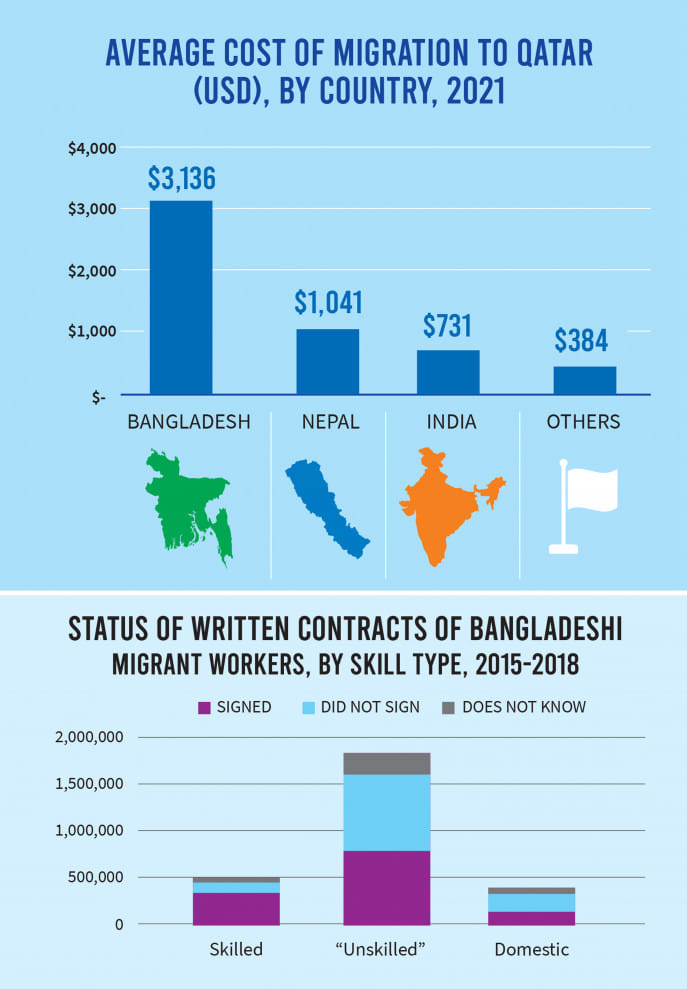Written by: Rufaida Aaneela
Nearly 1,105,992 female laborers migrated for employment opportunities abroad in 2022, compared to 33,000 in 2012, and the lion’s share of such employment opportunities takes place in KSA, as per BMET. There are several migration rules and regulations that can significantly affect the condition of female migrants, such as The Overseas Employment and Migrants Act (OEMA) 2013, The Expatriates Welfare and Overseas Employment Policy 2016, National Skills Development Policy 2011, Recruiting Agents Conduct and Licence Rules 2002 and so on.
The 7th and 8th five-year plans, Vision 2021 also recognizes the role of migration and remittance in the national economy, and at the same time Ministry of Expatriates’ Welfare & Overseas Employment also recognizes female migrant’s contribution and states measures to increase participation, opportunities abroad, skill development and safety (UN Women,2018).
Notably, the actions of The Expatriates Welfare and Overseas Employment Policy 2016 on a special wing for female migrants, the incorporation of civil society, international organizations, and NGOs have gained immense appreciation due to the gender-sensitive policy frameworks (UN Women,2019).
While the OEMA covers important grounds for protecting migrant workers, such as requiring written employment contracts, establishing Labour Welfare Wings in receiving states to address workers’ complaints, prohibiting illegal recruitment activities, safeguarding migrants, and so on, there has been a significant gap between the OEMA’s intentions and its implementation over the decade since its enactment. The operations of Dalal, no written contracts, high recruitment costs, the absence of labor wings, and safeguarding measures profoundly rooted in the labor migration institutional structure, persisted (Rahman,2023).
While an updated OEMA 2013 is being drafted, analyzing some of the best-practiced laws and policies from neighboring nations might provide opportunities to identify gaps and strengthen the policy and its implications for Bangladeshi female migrants.
1. The Philippine Embassy in the United Arab Emirates and Lebanon runs programs to educate female domestic workers and assist them in transitioning out of the unskilled labor category. The embassy offers free classes on computer literacy, cooking, needlework, photography, and so on (UN Women,2018).
2. In Jordan, the Ministry of Labour has established a Domestic Workers Directorate responsible for overseeing employment agencies and domestic workers addressing difficulties impacting domestic servants (UN Women,2019).
🔵 Since a large number of Bangladeshi women migrate as domestic workers, in the unskilled or semi-skilled labor categories, such initiatives can become beneficial for female migrants as well as the cost and sending countries in the long run.
3. Certain public sites in Hong Kong are designated as gathering places for various nationalities of migrant domestic workers, including Filipinas, Indonesians, Thais, Nepalis, and others. On workers’ leisure days, several migrant associations organize their activities in these places (UN Women,2018).
🔵 Such arrangements can also become a source of both connectivity and rights awareness practice for Bangladeshi female migrants, especially in Middle Eastern countries where a large number of females migrate from Bangladesh. While both embassies concerned can first develop such an agreement, the Bangladeshi embassy abroad can also host monthly gatherings at its premises. Such an arrangement will also aid in the monitoring of domestic workers’ conditions, the generation of data, and the enhancement of the concept of leadership and bonding among migrants.
4. Migrant domestic workers in Italy and South Africa have the same protection and benefits as other workers, including minimum wages, medical benefits, one day of rest every seven, paid annual leave, a 13th-month salary, and a written contract that must be in accordance with labor law and is thus enforceable in court (UN Women,2018).
🔵 Such provisions, when introduced, can be beneficial for both host and origin countries.
5. As part of the Making Migration Safe for Women program in Niger, focus groups were held with migrant women to assess their pre-migration information and desired information before departure. Focus group talks revealed how migrant women in Niger access information, their preferred sources, and safe migration information delivery methods (e.g., training, radio ads, peer educators, online). Migrant women’s perspectives shaped program activities to give them the information they needed to make their migration safe and fulfilling (UN Women,2023).
🔵 While some local-level NGOs conducted such small-scale FGDs, the ministry can conduct such activities on a much larger scale to incorporate the voice of all, since it arranges and determines the policies and maintains international cooperation with the embassies.
6. India has formed a gender budget department to develop schemes for women migrants, review the advantages of reaching women through current schemes, and develop provisions and targets for women (UN Women,2019).
🔵 While the specific focus of The Expatriates Welfare and Overseas Employment Policy 2016 was an appreciation for its designated services for female migrants, incorporating a gender budget can be a timely initiative.
Although existing policy measures stress timely needs, institutional inadequacies and a lack of awareness and information among migrants make implementation challenging. While Bangladesh is still recovering from the setback this sector had following COVID-19, multi-stakeholder involvement and structured accountability mechanisms, in addition to adopting several well-known regional models, should be rigorously explored.
This article is 𝐏𝐚𝐫𝐭-𝟎𝟐 of YPF safe Migration Policy Team’s”𝐁𝐞𝐡𝐢𝐧𝐝 𝐭𝐡𝐞 𝐉𝐨𝐮𝐫𝐧𝐞𝐲𝐬: 𝐄𝐱𝐩𝐥𝐨𝐫𝐢𝐧𝐠 𝐌𝐢𝐠𝐫𝐚𝐭𝐢𝐨𝐧” series.
To Read Part- 01 Click Here
To Read Part-03 Click Here
To Read Part-04 Click Here
To Read Part-05 Click Here
To Read Part-06 Click Here
Reference:
- BMET (2023), Overseas Employment of Female Workers (Country wise – Yearly) from 1991 to 2022.
old.bmet.gov.bd/BMET/viewStatReport.action?reportnumber=25 - Rahman,S.P.(2023),From ‘Act’ to ‘Action’: Protecting migrant workers through the Overseas Employment and Migrants Act,The Business Srandard.
From ‘Act’ to ‘Action’: Protecting migrant workers through the Overseas Employment and Migrants Act | The Business Standard (tbsnews.net) - UN Women, (2018), Women And Migration In Bangladesh, Country Report.
Country-Overview-on-UN-WOMEN-migration.pdf (unwomen.org) - UN Women ,(2019), Making International Labour Migration Governance Gender-Responsive For Women Migrant Workers from South Asia.
ap-1-UNW_Policy-Brief.pdf (unwomen.org) - UN Women,(2023), Strengthening Migration Programming From A Gender Perspective Lessons Learned.
unwomen.org/sites/default/files/2023-06/Strengthening-migration-programming-from-a-gender-perspective-Lessons-learned-en.pdf
Featured Image Courtesy: The Business Standard
